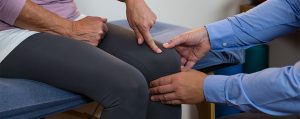Overuse Foot and Ankle Injuries in Gymnasts
Foot and ankle injuries can occur during various sports, but a shoe or cleat may protect the foot from more severe injuries. However, some sports are performed barefoot, such as gymnastics. Gymnasts have high demands on their feet and ankle, especially when landing their skills on vault, bars, floor, and beam. Gymnastics places high impact forces and high repetitions on growing young athletes. Gymnasts train all year and are therefore susceptible to overuse injuries.
Hand and Wrist Injuries in Gymnasts
Gymnastics is a unique sport where athletes spend a large amount of time on their hands. Handstands, tumbling, rings, and bars require the athlete to place their entire body weight through the arms and into the hands. Other sports do not place these heavy demands on the upper extremity. When tumbling, the athlete puts not only their entire body weight through the hands but can have up to 16 times their body weight in force going across the wrist2. No wonder 80% of gymnasts will experience wrist pain at some point in their career!6 In a study comparing injuries in male and female collegiate gymnasts, men suffered more hand and wrist injuries than their female counterparts1. We will be taking a closer look at the types of hand and wrist injuries both male and female gymnasts may experience and how to treat or prevent these injuries.
Knee Injuries Seen in Gymnasts
Knee pain in young gymnasts is a common complaint. Many times these young athletes begin having pain due to overuse of the area. A common overuse injury is Osgood-Schlatter’s disease (OSD). OSD is inflammation of the patellar ligament below the kneecap. Often, there is a painful bump below the kneecap (the tibial tuberosity) where the ligament attaches.
How Team USA Rhythmic Gymnasts are Staying Active at Home
Co Authors: Team USA’s Laura Zeng and Evita Griskenas
With continued shelter in place orders across the country, many athletes are having to alter training and competition schedules including Team USA’s Rhythmic Gymnasts. Unable to attend practice as they normally would, their competition season has been interrupted along with the delay of the Tokyo Olympics. Laura Zeng and Evita Griskenas, two of Team USA’s top rhythmic gymnasts, give us insight into what they are doing at home to stay active and prevent injury as well as tips for other rhythmic gymnasts.
Achilles Tendinitis in Gymnasts
Tendinitis is a chronic, overuse type of injury that is common in gymnasts as they perform multiple repetitions of their routines – on the floor, beam and when sprinting toward the vault. Rhythmic gymnasts are also at risk due to performing up to four different routines on the floor with repetitive jumping, leaping and turning.
Ankle Strengthening for Tumbling Athletes
Gymnasts and cheerleaders are two types of athletes whose sports require tumbling. Tumbling can range from cartwheels to more complex flips and twists. Regardless of the difficulty of the tumbling, strong ankles for pushing off and landing are important. Weakness in ankles can result in injury such as an ankle sprain, ankle fracture, or tendinitis in muscles surrounding the ankle.
Shoulder Strengthening Exercises for Male Gymnasts
Gymnastics is a sport with large demands on the upper body. Male gymnasts especially rely on the strength and stabilization of the upper body for many of their events such as rings, pommel horse, vault, high bar, parallel bar and floor. Research has shown that a gymnast can experience up to 16 times their body weight through their arms during gymnastics events.1 Injuries are often seen at the shoulders in the male gymnast. In addition to overall shoulder strength, male gymnasts need shoulder stability to perform their sport.
Common Wrist Injuries in Male Gymnasts
Male gymnasts encounter different stresses on their joints compared to their female counterparts due to differences in the events they compete. In men’s gymnastics, there are multiple events that place stress across the joints of the arm including the rings, high bar, parallel bars and pommel horse.
